Insects
Insects (Insecta) are the largest group within the arthropod phylum. They have a solid chitinous exoskeleton, divided body, and segmented legs. Insects are the most diverse group of animals. It includes more than a million described species, with an estimated hundreds of thousands of species still waiting to be discovered.
The body of an insect is formed of parts. These parts are easily recognizable: the head (formed from six segments), thorax (formed from three segments), and abdomen (formed from 11 - 12 segments).
The insect has compound eyes on its head. Simple eyes (ocelli) have been preserved on the top of some groups of insects. The antennae are an essential organ of smell and touch. Antennae's shape is different. The primary type of the mouthparts of insects is chewing, but in many groups, specialized devices have developed - chewing-licking (bees), piercing-sucking (mosquitoes, Heteroptera), licking-sucking (butterflies).
The insect's thorax has three segments (the prothorax, mesothorax, and metathorax). There is one pair of legs on each thorax segment. So they have three pairs of jointed legs. It is an important distinguishing feature. Several very insect-like organisms (such as spiders or crustaceans) have four or more pairs of legs. Each species has legs adapted to its own needs. The leg consists of a coxa, one trochanter, the femur, the tibia, the tarsus, and the pretarsus. The second and third thoracic segments of insects can carry one pair of wings each. However, both pairs of wings are rarely the same. In some species, they are stunted or not developed at all. Accordingly, we divide insects into wingless Apterygota and winged Pterygota.
Insects breathe through the tracheae. It is a system of branched tubes reinforced with chitin, which reaches into all tissues and distributes atmospheric oxygen. The nervous system is ladder-like and consists of a large cerebral brain - supraesophageal ganglion, protocerebrum, deutocerebrum, tritocerebrum, and several small abdominal areas ganglia.
The abundance of insects depends on many factors. Because they are small animals, they can occupy areas inaccessible to other animals. Their abundance significantly depends on climatic conditions and food sufficiency. The number of species per area unit increases in the areas closer to the equator. Most species live in the tropics around the equator. Under suitable conditions, insects reproduce very quickly
Insects reproduce mainly sexually - by fertilized eggs, but sometimes also asexually - by eggs, which the female lays without mating with the male (parthenogenesis). The larvae hatch from the eggs. Depending on how the larvae develop, we distinguish between insects with complete metamorphosis and incomplete metamorphosis. First, the larva goes through the pupa stage, and then the adult imago (coleopteran, hymenopteran, dipteran, lepidopteran) hatches from the pupa in the complete metamorphosis. In incomplete metamorphosis, the larva gradually becomes an adult without going through the pupal stage (heteropteran, grasshoppers). The duration of the individual stages varies considerably.
Insects are divided according to their importance for humans into four groups:
1. Beneficial insects - insects whose products are used by humans (honey, wax, propolis, silk, etc.).
2. Helpful insects - pollinate flowers, produce honey, significantly regulate the condition of other (harmful) insects, help eliminate dead organisms, affect soil quality, etc.
3. Harmful insects - parasitize on animals and humans, damage plants, destroy food, transmit various infectious diseases, etc.
4. Indifferent insects - other insects.
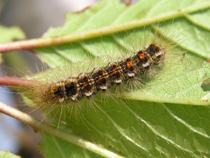 |
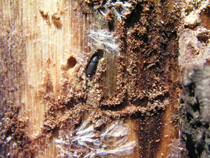 |
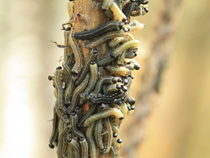 |
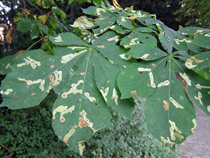 |
|
Euproctis chrysorrhoea. Photo: M. Zúbrik |
Hylastes ater. Photo: M. Zúbrik | Neodiprion sertifer. Photo: M. Zúbrik | Cameraria ohridella. Photo: M. Zúbrik |
The most harmful insect from bark beetles and wood-destroying insects in Central Europe is the European spruce bark beetle.
It has up to three generations in our conditions within one season. In spruces and other coniferous forests up to 50 years, the six toothed bark beetles are a serious pest. Bionomy and protection are similar to European spruce bark beetle. Striped ambrosia beetle belongs to technical pests of coniferous wood; it mechanically damages sapwood and heartwood of cut trees. It does not directly endanger the health of the trees, but its proliferation in the stand is undesirable. Other bark beetles include. Other bark beetles include, e.g., bark beetles on pine and fir, large larch bark beetle, the European oak bark beetle.
The harmful effects of leaf-eating and sucking insects are considered less dangerous than bark beetles. However, caterpillars and false caterpillars are particularly harmful by feeding and sucking on the leaves of deciduous and coniferous trees. One of the most harmful species in this group is the gypsy moth, which outbreaks every 7 to 10 years in oak stands, where it causes defoliation. Gradation lasts 3-4 years, while thausends of hectares are damaged each year in Europe. Protection consists of aerial treatment of valuable production stands with biological and biotechnical agents in the range of 5 - 20,000 ha each year during the gradation. After the gradation of the gypsy moth, the geometer moths reproduce in these stands, but with less harmful effects. In some localities of oak stands, the green oak tortrix is a serious pest. In beeches, pale tussock proliferate. In larch stands, larch casebearer causes damages on needles. In its occurrence, even aerial treatment is often not effective due to caterpillars' hidden way of life.
Common pine sawflies on pine needles are damaged; web-spinning sawflies on spruce. Aphids are sucking insects damaged on larches and spruces. Their action reduces the assimilation area of the needles, deforms the shoots, and it is a predisposition to fungal infection. In forest nurseries, plantings, and young plantations, severe damage to capillary roots is caused by larvae of click beetles, crane flies. White grubs (larvae of cockchafers) feed on thicker roots; European mole crickets feed on the thickest ones (more than 1 cm). In addition, the bark of the roots and root necks is eaten by weevils, Hylastes cunicularius, and large pine weevil.
ORDER HEMIPTERA
The order Hemiptera is divided into two suborders: Heteroptera (Bugs) Homoptera (Cicadas, Hoppers, Psyllids, Whiteflies, Aphids, and Scale insects)
Most species are phytophagous, have piercing-sucking mouthparts, feed on the juices of herbs and woody plants, which pierce in various places: on roots, trunks, branches, leaves, needles, and buds. Among them are species monophagous, narrowly and broadly oligophagous, and polyphagous. In addition, some species cause-specific neoplasms of "galls" in damaged plant sites, such as aphids from the Pemphigidae and Adelgidae families.
After hatching from the egg, development takes place through complex types of incomplete metamorphosis. Thus, paurometabolism, such as Psyllinae, holometabolism, e.g., Adelgidae, allometabolism Aleyrodidae, already indicates a complete metamorphosis.
Many species of this order are important pests in agriculture, fruit growing, and forestry. The harmfulness lies in the suction of plant juices; some species transmit viral diseases, cause neoplasms, many secrete sweet sticky feces (honeydew), which stick to the assimilation organs, thus restricting breathing.
The Aphidoidea group of the Hemiptera order includes approximately 750 small species with delicate bodies. Representatives of the families Aphididae (true aphids), Lachnidae (giant aphids), Pemphigidae (woolly aphids), and Adelgidae (pine or spruce aphids) are responsible for most of the problems that aphids cause in forests.
Scots pine aphid (Cinara pini) is the most abundant pest found to suck among the needles of pines on the branches. It is 3.5 - 4 mm in size. If the miniature individuals (up to 1 mm) sucking on the twigs are densely covered with wax wool, it may be pine woolly aphid (Pineus pini). The Buchneria pectinattae (green, 3.5 mm large) and Todolachus piceae (black) live individually among the fir needles. The balsam twig-aphid (Mindarus abietinus) twists the needle at the top, silver fir woolly adelgid (Dreyfusia nordmannianae) at the bottom. The balsam woolly aphid (Dreyfusia piceae) lives on the trunk of older firs. Smaller colonies of large species from the conifer aphids (Lachnidae) suckle between the spruce needles. E.g. Lachniella constata or Cinara piceae. Typical galls on the spruce form the pale spruce gall adelgid (Adelges laricis) and the spruce pineapple gall adelgid (Sacchiphantes viridis). On young shoots of larche sucks Cinara laricicola and Cinara laricis. However, the most significant damage is caused by the spruce pineapple gall adelgid (Sacchiphantes viridis) and the pale spruce gall adelgid (Adelges laricis). The most abundant insect on the beeches, sucking on leaves, is the woolly beech aphid (Phyllaphis fagi). On the oak branches, frequently occur the variegated oak aphid (Lachnus roboris). On the elm leaves, the galls are formed by the European elm leafcurl aphid (Eriosoma ulmi) and the elm sack gall aphid (Tetraneura ulmi). On ash leaves, eafcurl ash aphid (Prociphilus fraxini) is harmful. Finally, the galls of various shapes on the leaf stalks of poplars are very abundant. They consist of, e.g., poplar aphid (Pemphigus filaginis) or poplar spiral gall aphid (Pemphigus spirothecae).
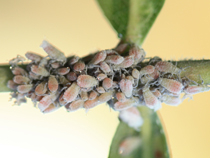 |
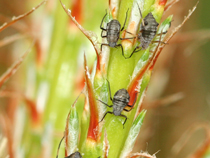 |
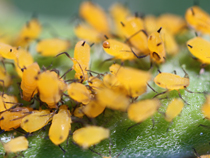 |
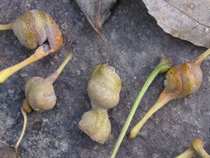 |
|
Prociphilus bumeliae. Photo: M. Zúbrik |
Cinara pini. Photo: M. Zubirk | Aphis nerii. Photo: M. Zúbrik | Pemphigus spirothecae. Photo: M. Zúbrik |
ORDER HYMENOPTERA
It is large and numerous order. The number of species occurring in our country is estimated at about 10,000. It includes our smallest insect species, with a body length of only 0.5 mm (e.g., in the family Trichogrammidae). The largest species reach 4 - 5 cm. Adults usually have two pairs of membranous, transparent wings. These can be in some groups stunted or only temporary (ants). There are cases when only one sex is winged - males.
The development of the Hymenopterans takes place through a complete metamorphosis. They reproduce via eggs. Females lay their eggs in plant tissues, on their surface, or in the bodies of their hosts. Worm-shaped larvae hatch from the eggs. Some wild-lived phytophagous larvae have a caterpillar shape (so-called false caterpillars) with three pairs of legs on the thorax, with different numbers of false legs (prolegs) on the segments of the abdomen. The pupae are primarily loose, and in most species, they are stored in cocoons. However, mummy-like pupae also occur, for example, by chalcids.
The Hymenoptera order is systematically divided into two suborders, according to how the abdomen is attached to the thorax. In the suborder Symphyta, the abdomen is connected to the thorax in full width; in the suborder Apocrita, it is connected by a petiole, which consists of the second abdominal member (the first is still involved in the construction of the thorax).
On young pines, larvae of web-spinning pine-sawfly (Acantholyda hieroglyphica) are harmful. Its caterpillar lives inside a spinning bag, on which its frass is captured. Common pine sawfly (Diprion pini) and European pine sawfly (Neodiprion sertifer) are harmful in stands up to 20 years of age. On spruce needles, the Cephalcia abietis is harmful. It preferentially attacks older spruce stands (over 60 years of age) in mountainous locations. The Euura montana (Pachynematus montanus) may attack older or middle-aged stands in higher altitudes. The false-caterpillars of gregarious spruce sawfly (Pristiphora abietina) damage younger stands, not older than 20-30 years. Larvae of birch leaf-mining sawflies (Fenusella nana) and dusky birch sawflies (Croesus latitarsus) live on birch leaves. A large group of species of the genus Andricus spp. and Cynips spp live on oaks. Their larvae live in galls. These include, for example, Andricus (Neuroterus) albipes, Andricus crispator, Andricus curvator, Andricus (Cynips) coronatus, Andricus kollari, Andricus lignicola, and others. Pontania proxima, Pontania vesicator, and Pontania viminalis live and harm willow leaves. Leafcutting bees Megachile spp. cut out oval cut-outs from the edge of the leaves. They will use the bitten-off leaf piece as a lining for future progeny in their nest. Sawflies (Siricidae) live in wood and technically degrade it.
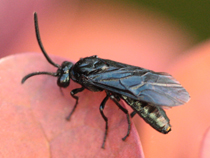 |
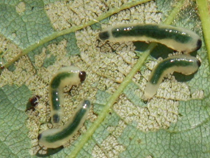 |
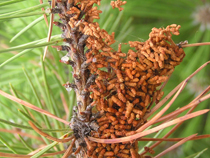 |
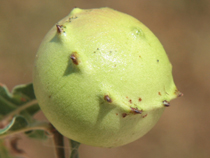 |
|
Arge berberidis. Photo: M. Zúbrik |
Caliroa annulipes. Photo: M. Zubirk | Acantholyda hieroglyphica. Photo: M. Zúbrik | Andricus quercustozae. Photo: M. Zúbrik |
ORDER COLEOPTERA (BEETLES)
With the number of genera and species, beetles are the most numerous order of insects with a very diverse shape, body size, and way of life. Although the smallest species are only about 0.5 - 1 mm long, the largest species in Europe reach 6 - 8.5 cm (Lucanus cervus). The largest species of beetles live in the Brazilian rainforests. Titan beetle (Titanus giganteus) can measure up to 16 cm, and Hercules beetle (Dynastes hercules) more than 18 cm.
A characteristic feature of beetles is the first pair's strong sclerotized wings, called elytra (wing covers). The second pair of wings are membranous, folded under the wing covers. In most species, wing covers cover the middle, back thorax, and entire abdomen. However, even the membranous wings of the second pair are sometimes reduced, incapable of flight, or disappear entirely. Then the wing covers are usually accrete along the middle seam.
Beetles have chewing mouthparts. Well-developed mouthparts have, for example, carnivorous species (Carabidae) and wood-destroying species (Cerambycidae)
Beetles reproduce by laying eggs. Development after hatching from the egg takes place by complete metamorphosis. The pupa is free, and all the primary organs and shapes of the forthcoming imago are visible. Most species pupate at the larval feeding site. Larval development takes various lengths of time. In some species, the larva develops to the pupal stage in 1-2 months, and such species can then have 2-3 generations per year (Scolytidae, Chrysomelidae, Coccinellidae, etc.). Other species need 3-4 years for larval development (Lucanidae, Cerambycidae, Melolontha spp., etc.).
The ecology of beetles is very diverse. The adults feed on plant tissues, plant remains, and some are even predatory. The larvae are primarily phytophagous, zoophagous, saprophagous, or predatory. They live freely in the ground, on the ground, in water, in rotting remains of plant and animal origin, on underground and above-ground parts of plants, in bast, wood, they eat needles, leaves, buds, or even flowers.
Beetles occur very often in nature and forests. They mean a significant part of biocenoses. Among them are very harmful, causing outbreaks, but also beneficial species. Some beetle species belong to the most important forest pests from the whole class of insects (European spruce bark beetle, pine bark beetle, etc.).
The dangerous pine shoot beetle (Tomicus minor) and the common pine shoot beetle (Tomicus piniperda) live on the pine trunk. In addition, silver-fir bark beetle (Pityokteines curvidens), European fir engraver beetle (Pityokteines vorontzowi), and fir engraver beetle (Pityokteines spinidens) are harmful on fir trunks. The most dangerous species to spruce are
- European spruce bark beetle (Ips typographus),
- six-toothed spruce bark beetle (Pityogenes chalcographus),
- small spruce bark beetle (Ips amitinus),
- double-spined bark beetle (Ips duplicatus), and
- fir bark beetle (Pityophthorus pityographus).
Striped ambrosia beetle (Trypodendron lineatum) is developed in various species of conifers. The great capricorn beetle (Cerambyx cerdo), Agrilus biguttatus, Chrysobothris affinis, and especially the dangerous European oak bark beetle (Scolytus intricatus) live in oak wood. Large European elm bark beetle (Scolytus scolytus) and smaller European elm bark beetle (Scolytus multistriatus) are harmful to elm. The leaves of willows are inhabited by larvae and the adults of spotted willow leaf beetle (Melasoma vigintipunctata) and willow leaf beetle (Lochmaea capreae). Also, the imago of the garden chafer (Phyllopertha horticola) is harmful to the leaves.
Larvae of large timberworm, European sapwood timberworm (Hylecoetus dermestoides) live in deciduous and coniferous woods. Abundant species in deciduous stands include the cockchafer of the genus Melolontha spp.
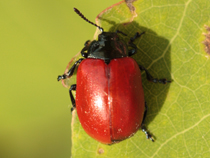 |
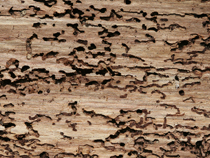 |
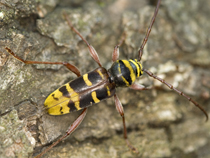 |
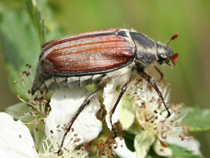 |
|
Melasoma populi. Photo: M. Zúbrik |
Polygraphus poligraphus. Photo: M. Zubirk | Plagionotus detritus. Photo: M. Zúbrik | Melolontha melolontha. Photo: M. Zúbrik |
ORDER LEPIDOPTERA (BUTTERFLIES, MOTHS)
The characteristic feature of butterflies/moths is two pairs of membranous wings, covered with scales all over the surface. There are many butterflies and moths live in Europe. The smallest measure in the wingspan is 0.4 mm; the largest is 7 - 8 cm. The largest giant peacock moth (Saturnia pyri) has a 10 - 13 cm wingspan.
By Lepidopterans, sexual dimorphism is common, manifested in the shape and length of the antennas, the color and size of the wings, sometimes in the winging (females of some species are winged or with wings significantly reduced so that they are unable to fly, for example, some species of the Geometridae family).
The mouthpart is of sucking type, forming a sucking pump of varying lengths, but it is stunted in many species and adults often do not eat.
Lepidoptera usually reproduce sexually and are egg-laying. After hatching, the development takes place by complete metamorphosis. The pupae are mummy-like in the vast majority of species. Females lay eggs one by one or in groups, most often on a nutrient plant of the larval stage - caterpillars. The caterpillars are naked or hairy, usually having three pairs of thoracic legs, four pairs of abdomen legs, and prolegs. Almost all caterpillars are phytophagous, most often eat leaves and needles, but they also live in the bark, under the bark in the phloem of trees, in shoots, in buds, in leaves and needles, where they eat corridors or mines (mining), then in cones, seeds, and fruits of fruit trees, in stored flour, in woolens, and furs. The caterpillars of some families make bags in which they stay and carry by them. The development of caterpillars usually takes 1-3 months, only in species that overwinter in the caterpillar stage longer.
Lepidopterans are harmful only at the larval stage; the adults feed on freely accessible plant juices or do not eat at all. Many butterflies/moths are indifferent, but many butterflies/moths belong to the most economically important insects. Among them are species that frequently reproduce and cause defoliation of deciduous and coniferous trees on large areas of vegetation. The gypsy moth (Lymantria dispar) is one of our most dangerous forest pests.
The caterpillars of the pine beauty moth (Panolis flammea), the pine-tree lappet moth (Dendrolimus pini), and the pine looper moth (Bupalus piniarius) damage the pine needles. The caterpillars of the pine shoot moth (Rhyacionia buoliana) live in buds. It causes undesirable growth deformations, especially in gardens, parks, and Christmas tree plantations.



